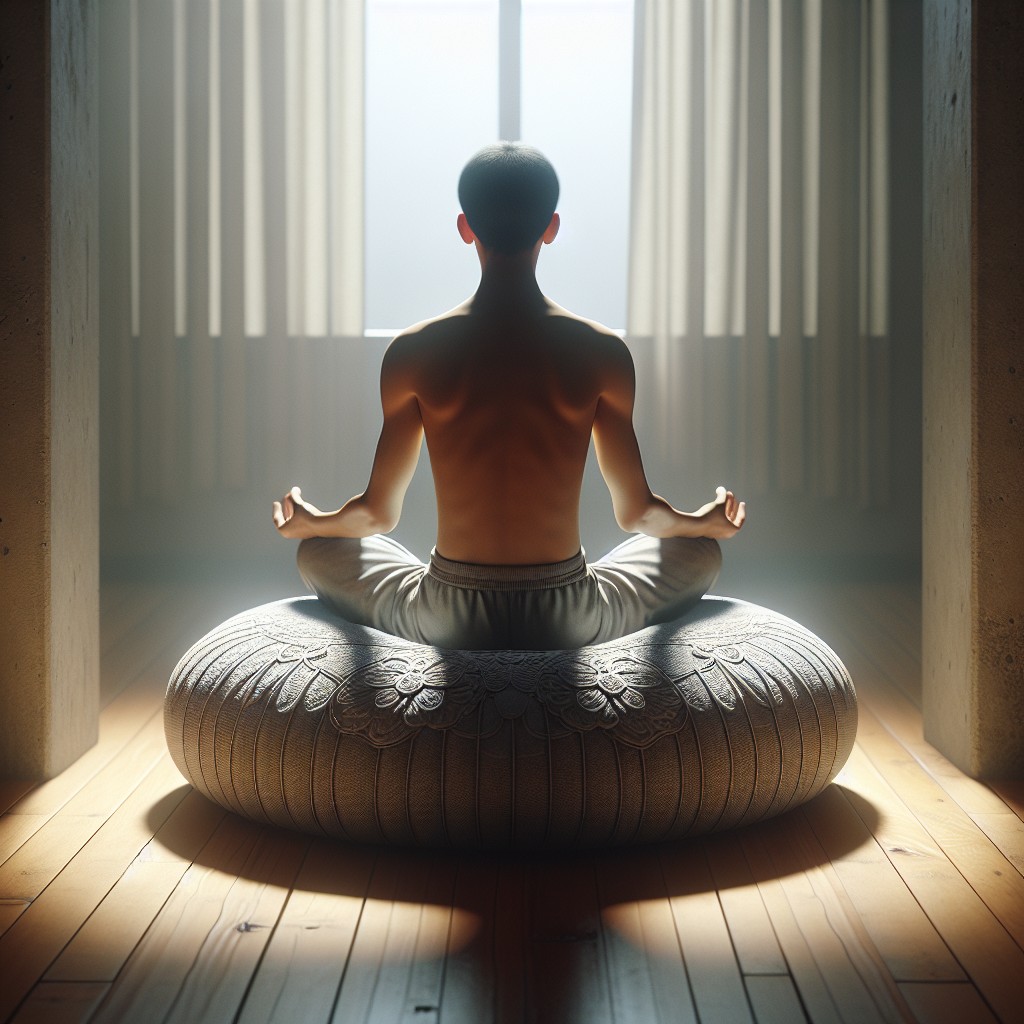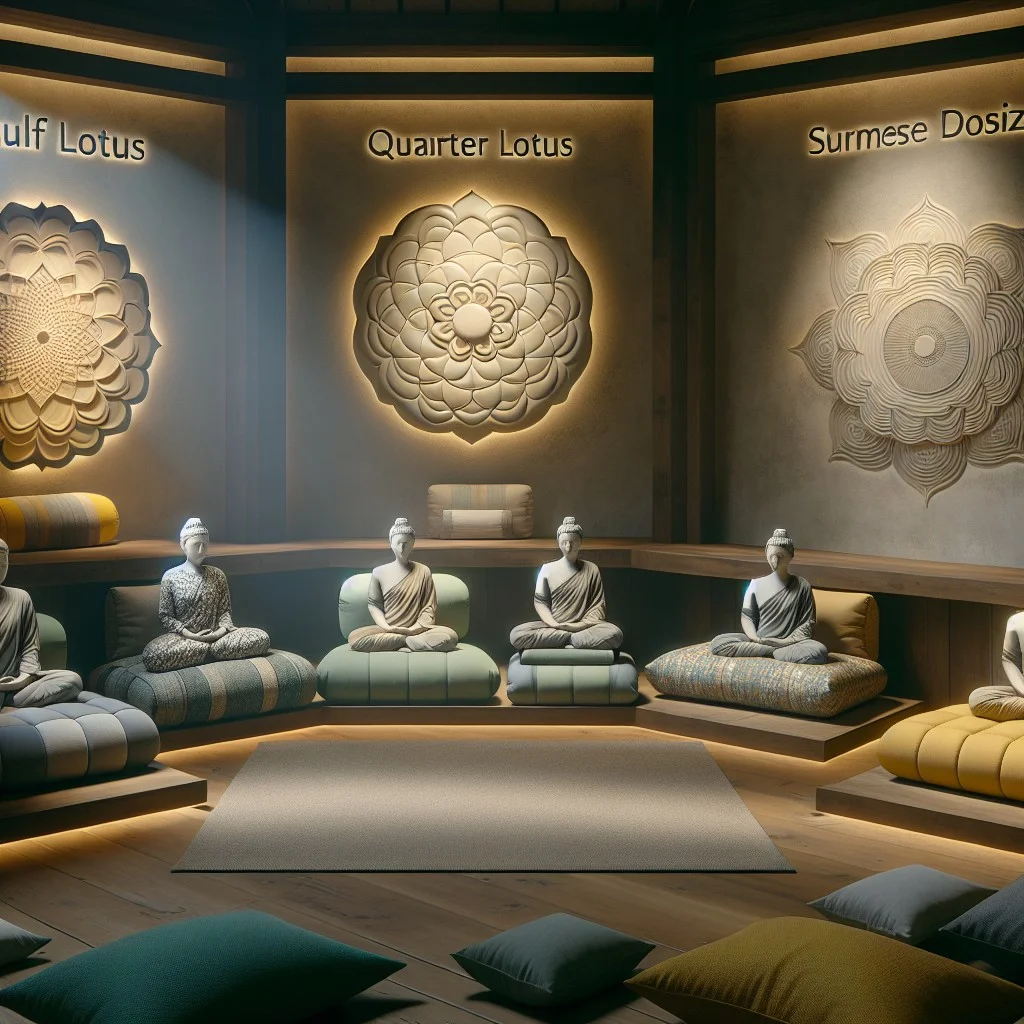Discover how to use a meditation pillow to enhance your mindful practices, because it can significantly improve your posture, comfort, and overall meditative experience.
Incorporating a meditation pillow into your mindfulness practice can significantly enhance comfort and posture, facilitating a deeper, more focused meditation session. This article provides a comprehensive guide on how to use a meditation pillow effectively to maximize its benefits.
From choosing the right pillow, positioning it correctly, to maintaining an optimal posture for meditation, every detail is meticulously covered. So, whether you’re a seasoned meditator or a beginner, this guide will help you leverage the advantages of a meditation pillow to enrich your mindfulness journey.
Key takeaways:
- Choosing the right meditation cushion: Material, filling, shape, size, and portability.
- Understanding the different types of meditation cushions: Zafu, zabuton, and crescent.
- Sitting on a meditation cushion: Proper placement, finding sit bones, crossing legs, aligning spine, relaxing shoulders, and positioning hands.
- Meditation cushion sitting positions: Half lotus, quarter lotus, full lotus, Burmese position, seiza position, and chair position.
- Adjusting your meditation cushion for optimal comfort: Tuning height, firmness, and position.
Choosing the Right Meditation Cushion

To choose a suitable cushion, consider these essential points:
1. Material: Select a cushion that can withstand daily use and maintain its shape. Fabrics like cotton or hemp are durable and comfortable.
2. Filling: Cushions can be filled with a variety of materials such as buckwheat hulls, kapok fiber, or memory foam. Buckwheat hulls conform to your shape and are best for supporting specific positions. Kapok fiber and memory foam are softer and offer a plush feel, suitable for longer meditations.
3. Shape: Meditation cushions come in round (Zafu), crescent, or rectangular (Zabuton) shapes. The choice of shape depends on your preferred meditation position. A Zafu works best for cross-legged positions, a Zabuton supports kneeling positions and a crescent cushion provides ample space for the thighs and hips when sitting.
4. Size and Height: Size of cushion should allow you to sit comfortably with your knees touching the ground for stability. The height should enable your hips to be elevated higher than your knees. This prevents discomfort and promotes good posture during meditation.
5. Portable: If travel is part of your lifestyle, you might want a foldable or lightweight cushion for mobility.
Every body is different, so the cushion that works best for you might not be the one your friend raves about. Trial and error might be necessary. Ultimately, it’s about supporting your body to ensure a relaxed yet erect posture for focused, mindful meditation.
Understanding Meditation Cushions

There are a plethora of options when it comes to meditation cushions, each designed to cater to different meditative postures and personal comfort needs. Primarily, they fall into three categories: zafu, zabuton, and crescent.
A zafu is a traditional round cushion, filled with buckwheat hulls for firm support, and it can be adjusted for loftiness. This is handy in accommodating different postures.
In contrast, a zabuton offers broader and softer support, making it ideal to reduce pressure on the knees and ankles during meditation. Some prefer to use a zabuton together with a zafu for added comfort.
The crescent meditation cushion is designed with a contoured shape, providing a wide range of support for the thighs and reducing pressure on the lower body, great for those who might have some flexibility issues.
They all facilitate an upright and balanced posture. This is critical as it aids in both concentration and the free flow of energy, creating an optimal environment for mindfulness. The choice ultimately depends on your personal comfort and preferred sitting style. Understanding these distinctions allows you to make a more informed decision so that your meditation experience can be as comfortable and effective as possible.
How to Sit On a Meditation Cushion

Sitting on a meditation cushion is not about merely finding a comfy spot; it’s about aligning your body to ensure energy flow and concentration. Here’s how to get started.
1. Place your cushion on a flat surface: This will ensure stability during meditation.
2. Find your sit bones: Sit on the edge of the cushion, allowing your sit bones to find a natural, balanced position. These bony parts at the base of your hips are crucial for proper alignment.
3. Cross your legs: If you’re using a traditional round or crescent cushion, the typical position is to sit cross-legged. For those with flexibility issues, a larger cushion where the legs can rest more open may work better.
4. Align your spine: Ensure your back is straight. Proper spinal alignment is critical for maintaining focus and avoiding discomfort.
5. Relax your shoulders: Roll them slightly back and down to release tension, allowing your arms to rest naturally by your side.
6. Position your hands: The most common positions are the cosmic mudra, where one hand rests on the other, palms up, with the thumbs lightly touching, or simply resting your hands on your knees.
Remember, the aim is to achieve a balance between comfort and alertness. Experiment with different positions until you find what best supports your meditation practice.
Meditation Cushion Sitting Positions: Half Lotus, Quarter Lotus, Full Lotus, Burmese Position, Seiza Position, Chair Position

Delving into different sitting positions, each provides unique advantages for meditative practices:
1. Half Lotus: This entails crossing one leg over the other while sitting on the cushion. While it requires flexibility, half lotus provides a stable base for meditation.
2. Quarter Lotus: With your feet resting on the ground and knees pointed sideways, you’ll find this position is easier to maintain and is recommended for beginners.
3. Full Lotus: Both feet resting on your thighs, with your knees aimed towards the cushion. This posture offers excellent stability but requires high flexibility.
4. Burmese Position: Both feet lie flat on the ground, giving you a wide and grounded foundation. Great for extended meditation sessions.
5. Seiza Position: Kneeling on the cushion with your butt resting on your heels. Use a higher cushion or a meditation bench for better support.
6. Chair Position: If flexibility is a challenge, you can sit on a chair with your feet flat on the floor and a small cushion for lumbar support.
Remember, the objective is to cultivate a posture that supports alertness and relaxation during meditation. Experiment and adjust to find what serves you best in your practice.
Adjusting Your Meditation Cushion for Optimal Comfort
To achieve excellent comfort levels during meditation, it’s pivotal to tune your cushion to your specific needs.
Firstly, consider the height of your meditation pillow. This factor greatly affects your posture, as too low could cause slouching, while too high might strain your hips. Adding or removing filling in your cushion could be a great way to fine-tune the height for your comfort.
The firmness of your cushion is another essential factor. You might prefer a softer seat, enabling you to mold it to your form, or perhaps you find a more robust, firm cushion better for your posture. Experimenting with different levels of firmness will help you find your perfect balance.
Lastly, consider the position of your meditation cushion. Traditionally, sit with your tailbone at the center-back of the cushion, leaning slightly forward. This positioning promotes your natural curvature and keeps your back straight, reducing discomfort and promoting focus during your meditation practice. With these adjustments, your meditation pillow should provide you with the optimal comfort you need.
Troubleshooting Common Issues While Sitting On a Meditation Cushion
When using a meditation cushion, you might encounter some common issues. It’s essential to address these to ensure your practice is comfortable and beneficial.
1. Feeling Unstable: If you feel wobbly or unstable, adjust the amount of filling in your cushion. Less filling can make the surface broader and more stable.
2. Lower Back Pain: Proper alignment is paramount. Sit on the front third of the cushion, letting your pelvis tilt forward naturally, creating an S-curve in your spine.
3. Leg or Feet Numbness: Experiment with different positions. Changing leg positions occasionally can help promote blood circulation and prevent numbness.
4. Neck Strain: Ensure your head is balanced directly over your spine. This affords the neck muscles a rest and prevents strain.
5. Physical Discomfort over Time: Remember, meditation should be comforting, not torturous. If discomfort persists, consider integrating yoga stretches into your routine or try a different cushion style.
It’s about hearing your body’s signals, making the required adjustments, ensuring healthy and comfortable meditation sessions.
Why Use a Meditation Cushion?
A meditation cushion can make all the difference in your mindfulness practice. Firstly, it elevates the hips, making it easier to maintain a straight, upright posture—crucial for effective meditation. Secondly, it provides comfort, minimizing discomfort or numbness during long periods of meditation. Lastly, it cultivates a dedicated space for meditation, reminding you to take a moment each day for mindfulness. The cushion itself becomes a symbol of your commitment to inner peace and self-awareness. The key is to understand its benefits and integrate it into your routine effectively.
Integrating Meditation Cushions Into Your Meditation Practice
Your meditation cushion should act as a tool to enhance the overall experience of your practice, rather than serving as merely a sitting accessory. Here are a few ways to seamlessly integrate it:
1. Setting Intention: Commence your practice by placing the cushion mindfully to set the intention before meditation. This helps in creating a sacred space for your practice.
2. Anchor for Mindfulness: During practice, you may find your thoughts begin to wander. Feel the cushion beneath you, the slight pressure and the texture can help re-anchor your attention to the present moment and to your body.
3. Deepening Sessions: As your practice matures over time, try varying the positions or height of the pillow. Balance should come easily, allowing for undisturbed concentration to delve deeper into your sessions.
4. Transitioning Mindfully: Once you finish meditating, resist the urge to immediately stand. Take a moment to connect with the cushion, acknowledging the balance and support it provided. This can extend the mindfulness practice beyond your meditation session.
Remember, a meditation cushion is integral to your practice as it not only promotes a proper posture but also evokes mindfulness. Aligning the purposeful use of the cushion with your practice helps to foster a more focused and balanced meditation experience.
FAQ
How does a meditation pillow work?
A meditation pillow works by elevating the hips above the floor to support the natural curvature of the lumbar spine, providing both comfort and support during meditation sessions.
Why do people use meditation pillows?
People use meditation pillows to offer essential spine support, enabling comfortable sitting for extended periods during their meditation practice.
Should I use a meditation pillow?
Using a meditation pillow can enhance your experience, but trying other available options such as a chair or a floor cushion initially can also be beneficial in determining the comfort level best suited for your practice.
What are the key benefits of using a meditation pillow?
A meditation pillow supports proper alignment, alleviates strain from sitting, enhances comfort during meditation, and aids in establishing a dedicated mindfulness practice.
How does a meditation pillow impact posture during practice?
A meditation pillow supports ideal alignment of the spine during practice, thus ensuring proper posture and maximum comfort.
What should one consider when choosing an appropriate meditation pillow?
When choosing an appropriate meditation pillow, it's important to consider its shape, size, fill, height, and the material to ensure comfort and correct posture during your mindfulness practice.